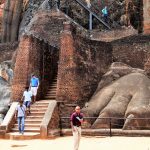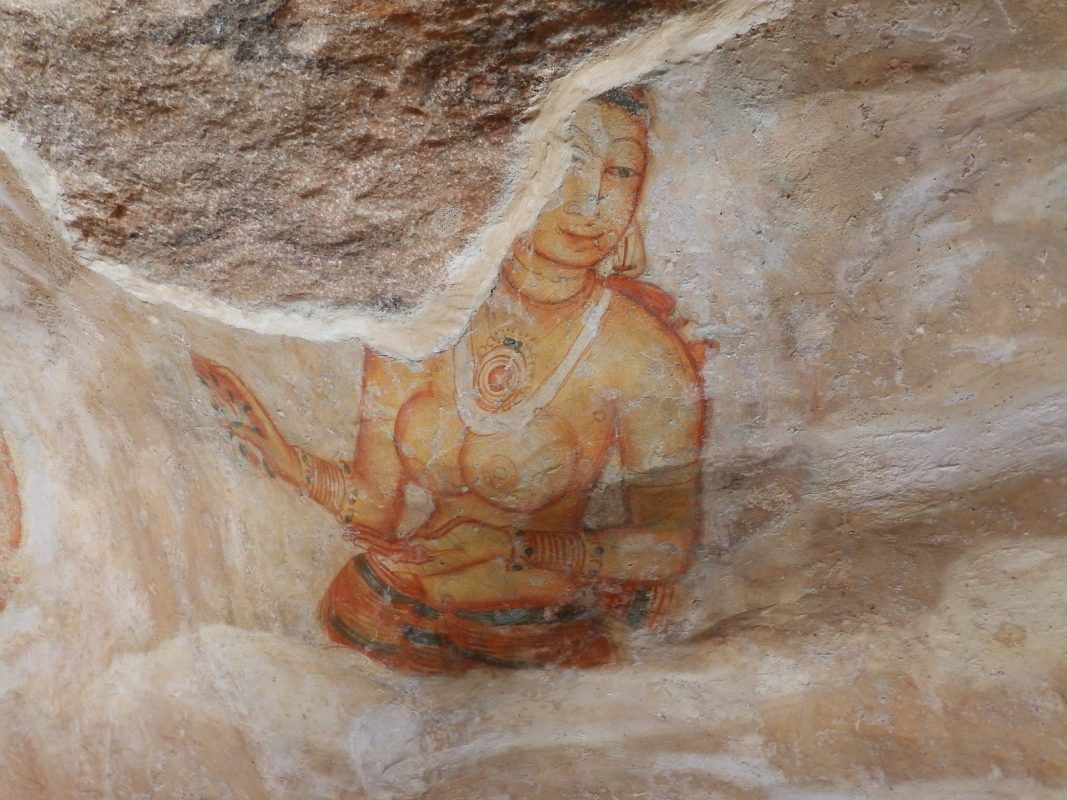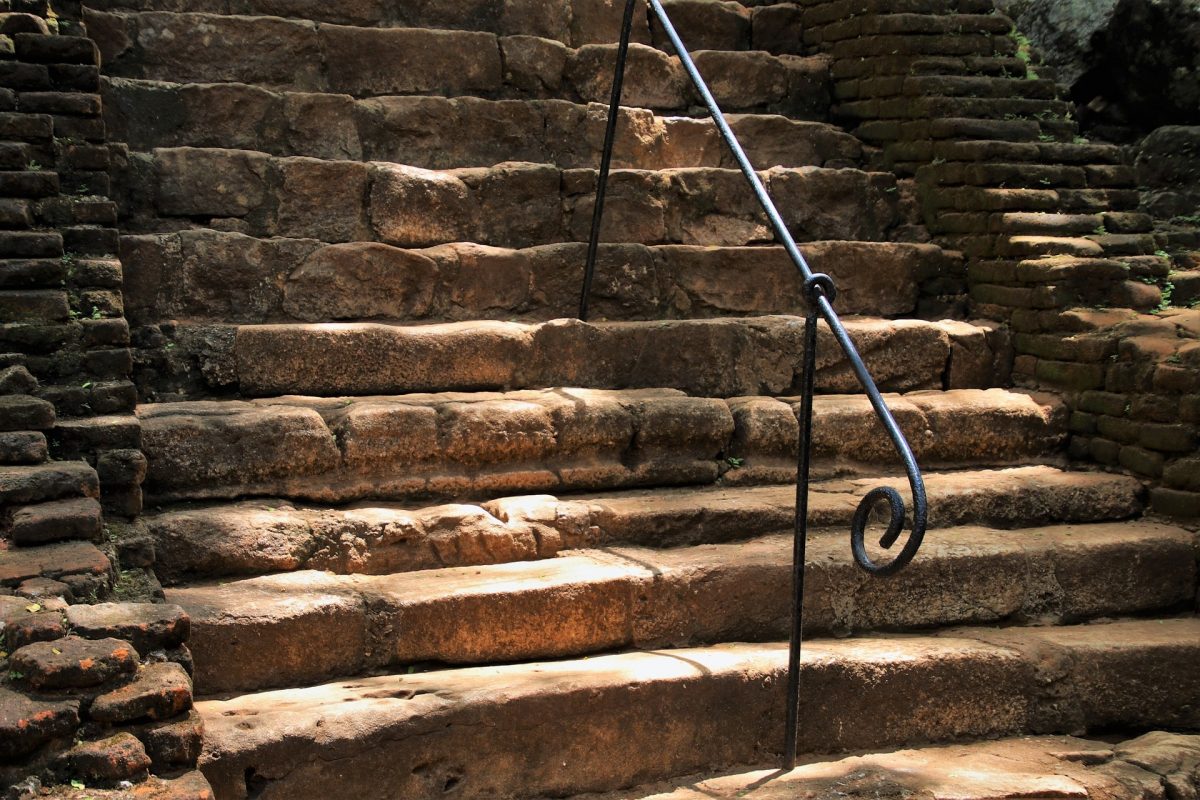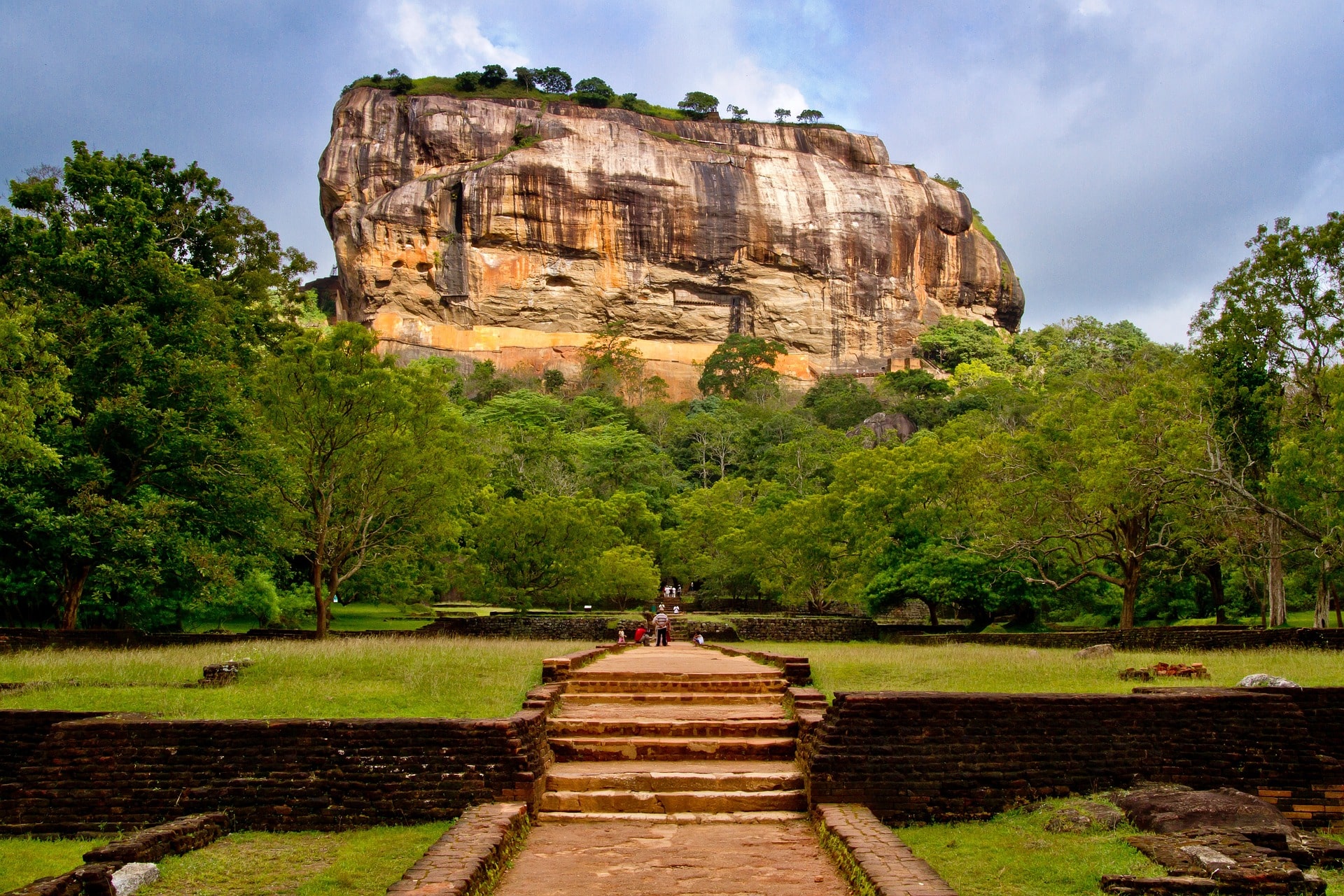“SIGIRI AAMI SITHUWAM BALIIMI NEIKA DANA LII HEYIN MAMA NOLIIMI” means I came to Sigiriya, Saw the place, many others have written on the wall, so I didn’t. This is graffiti on the mirror wall of Sigiriya.
Sigiriya, also called Sinha-giri (the rock of the Lion), is a historic rock fortress close to the town of Dambulla in the Central Province of Sri Lanka’s Matale District. Named after a massive rock column that is about One hundred eighty meters (590 feet) tall stands out at the historical and archaeological site. With its fortified channels and lovely water gardens with elaborate irrigation systems typical of our early kings, Sigiriya, a UNESCO World Heritage Site, is one of the best examples of ancient architecture in the entire world.
Last weekend we explored Sigiriya: the mysterious ancient Palace of King Kashyapa.
We saw the frescoes, the Lion staircase, and the Summit of the palace. It was a great sunny day, and the trip was to visit Sigiriya. It was a great sunny day! The journey took around 3 hours to reach our destination. Though the journey was a little bit tiring, the whole tiredness vanished like bubbles in a beer just after we went there.
At the very beginning, we had to pass the water gardens from Fountain garden to Boulder Garden. But it was pretty much easy to climb.
The first stage of the climb, Sigiriya rock, starts at the end of the Fountain Gardens and goes up to the Boulder Gardens. There were just a few steps, and it was easy to climb. There were rock shelters beneath a lot of giant boulders. These used to be brightly decorated. It was possible that several platforms in this area once housed numerous sizable open-air pavilions. It took around 5 to 10 minutes for us to climb this. According to historical records, they say that the fountain gardens look the same as the Water gardens of the Middle East and ancient Rome.
Several palaces and bathing pavilions dotted the gardens, and the area was covered in rich vegetation (due to the water system that supplied the connected tanks and ponds). The royal family intended to use this leisure palace, these water gardens, as a place to unwind. Every park has unique qualities that make it stand out. The Fountain Garden is primarily a display of Sigiriya’s hydraulics and intended as a display.
Sections in Sigiriya Water garden.
This water garden consists of four main sections:
- Miniature water garden,
- Water Garden 01,
- Water Garden 02 (also known as fountain garden), and
- Water Garden 03.
The miniature water gardens are inside the west entrance, beneath Garden 1’s interlocking pools. This garden is divided into at least five separate units, consisting of brick and limestone pavilions, paved water-retaining structures, and winding watercourses. The complex’s pavilions, each 90 meters long and 30 meters wide, were kept cool by slow-moving water that ran over the pebbled and marbled floors. An intricate network of underground conduits connected each pool and pavilion; this hydraulic system was even more complex than the fountain gardens in Water Garden 02.
You can find Water Garden 01 immediately after the miniature water gardens from the central (west) entrance. It consists of four interlocking, L-shaped pools that meet at intersecting walkways arranged in the directions of North, South, East, and West on the cardinal compass.
The only pools that have been restored have polished walls, an adjacent terrace, and steps that descend to the water’s edge. The central area between the four pools was once an excellent pavilion area. These pools were a part of a sizable complex of pleasure gardens that the royal family enjoyed; it was a peaceful setting of water and vegetation. Underground pipes that control the water level connect the four pools.
Anyone can reach Water Garden 02 by continuing along the main walkway from the center axis of Water Garden 01. The walkway to the boulder and terrace gardens passes by this garden, located in a small area on either side. There are two parts to it. Two long pools with stepped cross-sections are situated in the lower. They may have served as pressure or storage chambers for the winding streams and fountains above them when they were initially square in shape. Shallow streams lined with marble slabs drain into these pools.
Every so often, Fountains made of perforated limestone in the winding creek. Within these streams, on the upper level of the Fountain Gardens, are fountains made of circular limestone slabs with perforations. The fountains run on a gravity feed system and feed by underground water conduits. Amazingly, the fountains still run during the rainy season, more than 1500 years after construction.
A winding stream and the remains of a royal pavilion with a throne can still see in the Fountain Gardens’ upper half.
The largest of the four gardens in terms of area, Water Garden 03 is largely hidden from view to the north and south of the Fountain Gardens. The Water Palaces of King Kashyapa are located on two islands that make up the majority of this garden. The channels separate them from the other parts of the water garden complex, and the boulders and trees hide them.
Due to these factors, visitors walking the main path to the Sigiriya Rock hardly notice this water garden. The Octagonal Tank, hidden behind the island to the north on the above map, signifies the change from the Water Gardens to the Boulder Gardens. Water Garden 03 is also a transitional garden.
After passing the Fountain Garden, we got the chance to reach the terraced garden. We had to give many idyllic staircases, some through leaning boulders. The area had numerous smaller caves.
Previously, these were lavishly decorated and equipped with benches so guests could relax while taking in the surroundings. A pavilion is almost there on top of every boulder. It was an actual creation of beauty.
There is also little to share with you about this marvelous terraced garden. I found this from reading many books. According to UNESCO, the Sigiriya Rock Gardens are compared to the Hanging Gardens of Babylon. The Terrace Gardens are created by building a series of rubble-retaining walls, each terrace rising above the other and circling the rock in a roughly concentric pattern.
According to the chronicles, two main paths lead through the Terrace Gardens, similar to the split boulder arch. the primary route travels from the west gate straight to the rock. The many different terrace levels are contained in the garden by the steps at the southern end of the Terrace Garden complex. The same complex hydraulic system in the Water Gardens is also visible here.
Chronicles also say that King Kashyapa used the Terrace Gardens’ upper levels as a pleasure garden, and the stairs were kept cool by fragrant water. Of course, the king would carry in a litter rather than having to descend the 900+ stairs from the Lion Staircase. Once there, the extraordinary steps made him feel comfortable as he enjoyed the Terrace Gardens. But this was a little bit challenging. We took about 15 minutes to pass the terraced garden.
After, we proceeded to the mirror wall.
Before that, as said earlier, the Zig-zag staircase was reached by ascending two large brick staircases that pass through several terraces. We got The Mirror Wall via this fantastic staircase. Also, there was a platform at the top of the zigzagging stairs, where we could catch our breath and take in the view.
The historical record says that after the death of King Kassapa, visitors to the Sigiriya Rock Fortress scribbled verses about the Sigiriya Lion and Sigiriya Damsels on the wall that runs beneath the Sigiriya frescoes. The name Sigiriya, which means “the Lion Rock,” is believed to have come from the fact that building a massive Lion statue made the rock look like a lion. Only two of the enormous paws from the original lion statue are now visible on the northern side of the stone. According to a verse written in graffiti on the Mirror wall, the Beauties on the Rock and the Lion of Sigiriya have been seen.
The stairway leading to the rock summit locates through Lion’s paw.
The northern side of Lion’s paw entrance has a sizable terrace with the ruins of older buildings. The first accent from the rock’s base ends on this terrace.
The Mirror Wall has a polished plaster finish and has been constructed using brick masonry. They say that many of the writings on the Mirror Wall date from the seventh to the eleventh centuries, and some were written by native women, demonstrating the literacy level among women at that time. These graffiti were created using metal writing utensils, which may have been widely used at the time for writing.

After a journey of 20 minutes, we came to a narrow spiral metal staircase from the mirror wall walkway that led up to the Sigiriya frescoes located 20 meters above.

According to books, the Sigiriya Frescoes has completed in 480 AD. This piece of art was the flagship of a vast palace complex constructed by King Kashyapa. But Only a few of these murals remain today. They glide effortlessly through the clouds, safely tucked away in this tiny, protected depression 100 meters above the earth. Some say they are celestial nymphs carrying flowers for the kings and people below to enjoy. Others say that they are the harem of Kashyapa’s queen and concubines. As this was a no-photography area, we had to leave the place soon after we saw them.
The hardest part of the climb up Sigiriya Rock was this. As you ascend a narrow steel gantry on the exposed side of the rock to the Summit, I’m confident that it may cause you to experience vertigo and jelly knees. We were able to see the grooves that the ancient builders had carved into the rock surface to serve as the footing for the original staircase by looking below.
Yes, we’ve arrived at last. We arrived at the Summit. By looking around and being amazed by the size of the Sky Palace ruins surrounding us. History says that King Kashyapa constructed the magnificent Sky Palace on the top of Sigiriya Rock more than 1600 years ago. It served as both the geometric center and the innermost shrine of the Sigiriya complex. The only people who resided there were the king, queen, and a small staff.
It is Sri Lanka’s oldest and best-preserved palace complex. Over 200 meters above the surrounding plain, the Sigiriya summit takes the shape of an elliptical stepped plateau measuring roughly 1.5 hectares, with a gradual slope along the ellipse’s long axis.
Partly manufactured and partly natural, created this slope.
This significant brick wall constructed to the very edge of the rock encircled the Summit; its footings are also clearly visible. This wall provided shelter from the monsoonal rain and strong winds. It appeared to someone standing below that it was an extension of the rock itself because it was painted white like the rest of the stone.
They are firmly constructed and relatively thick structures with low-profile roofs. Isn’t those magnificent? We spent hours at the Summit and began to climb down. Though the climbing was tough, climbing down was a little easy for our knees. Sigiriya is a huge blessing. It is a masterpiece of architecture and engineering technology of ancient Sri Lankans. The irrigation technology that has been used is so immersed. Finally, it is a brilliant masterpiece.





Comments are closed.